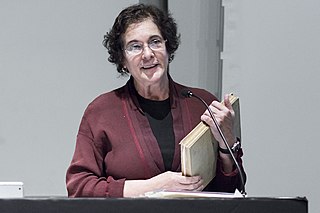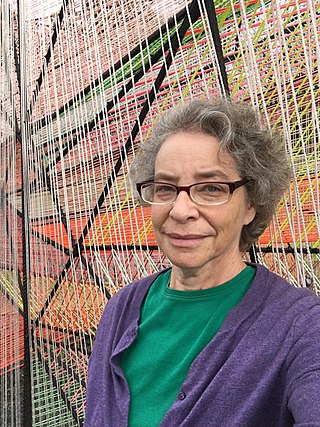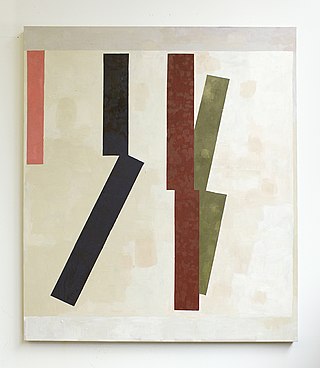Leila Christine Nadir is an artist and writer and Associate Professor at the University of Rochester, where she is also Founding Director of the Environmental Humanities Program. [1]
Leila Christine Nadir is an artist and writer and Associate Professor at the University of Rochester, where she is also Founding Director of the Environmental Humanities Program. [1]
Nadir grew up in an Afghan-American family in rural Western New York State. She credits her parents' marriage for her "high tolerance for insanity" and lack of tolerance for all sentimental clichés, especially about bicultural experiences. [2] She has a BA from Syracuse University and an MA and PhD in English & Comparative Literature from Columbia University. [3] She has been an art-resident at Bemis Center for Contemporary Art and at Center for Land Use Interpretation. She is a former Mellon Foundation Post-Doctoral Fellow of Environmental Humanities at Wellesley College. [4]
Nadir works as both a writer and artist, often with the artist Cary Adams. [5] Her writing is published by scholarly journals, literary magazines and popular periodicals, including North American Review , Asian American Literary Review , American Scientist , Leonardo , Hyperallergic , and Rhizome . As co-founder of the Ecoarttech art-media collaborative with artist Cary Peppermint, Nadir has presented creative projects and workshops at the Whitney Museum of American Art, the New Museum, and the Neuberger Museum, and gives regular lectures worldwide. She currently teaches humanities courses in the Sustainability and Media Studies programs of the University of Rochester. [6]
Nadir's memoir work, such as Bad Muslim (2018), revolves around her mixed-ethnicity upbringing and the colorful marriage of her Afghan, Muslim father and Slovak, Catholic mother, who together raised seven children. In "Life After Ruins," she writes that growing up in the Afghan-American diaspora has made the past a "constant preoccupation," inspiring her memoir writing. [7]
Nadir's artworks focus on practices of healing amidst personal and ecological traumas. [8] With artist Cary Peppermint, she creates art about food and environment that redresses a cultural-memory disorder that they call Industrial Amnesia. [9] [10] Their collaborations intertwine microbial, digital, and artistic cultures through fermentation-based workshops, reading groups, and dinners with the public. [11] Their video work, Probiotics of the Kitchen (2015) restages Martha Rosler’s Semiotics of the Kitchen (1975) forty years later. [12] [13]
She is a founding member of the NYC-based Afghan American Artists and Writers Association. [14]

Leila Fuad Aboulela is a fiction writer, essayist, and playwright of Sudanese origin based in Aberdeen, Scotland. She grew up in Khartoum, Sudan, and moved to Scotland in 1990 where she began her literary career. Until 2023, Aboulela has published six novels and several short stories, which have been translated into fifteen languages. Her most popular novels, Minaret (2005) and The Translator (1999) both feature the stories of Muslim women in the UK and were longlisted for the International Dublin Literary Award and Orange Prize. Aboulela’s works have been included in publications such as Harper's Magazine, Granta, The Washington Post and The Guardian. BBC Radio has adapted her work extensively and broadcast a number of her plays, including The Insider, The Mystic Life and the historical drama The Lion of Chechnya. The five-part radio serialization of her 1999 novel The Translator was short-listed for the Race In the Media Award (RIMA).

Shu Lea Cheang is a Taiwanese-American artist and filmmaker who lived and worked in New York City in the 1980s and 90s, until relocating to Europe in 2000. Cheang received a BA in history from the National Taiwan University in 1976 and an MA in Cinema Studies from New York University in 1979. Since the 1980s, as a multimedia and new-media artist, she has navigated topics of ethnic stereotyping, sexual politics, and institutional oppression with her radical experimentations in digital realms. She drafts sci-fi narratives in her film scenario and artwork imagination, crafting her own “science” fiction genre of new queer cinema. From homesteading cyberspace in the 1990s to her current retreat to post net-crash BioNet zone, Cheang takes on viral love, bio hack in her current cycle of works.

Lila Abu-Lughod is a Palestinian-American anthropologist. She is the Joseph L. Buttenweiser Professor of Social Science in the Department of Anthropology at Columbia University in New York City. She specializes in ethnographic research in the Arab world, and her seven books cover topics including sentiment and poetry, nationalism and media, gender politics and the politics of memory.

Cary Peppermint is a New York-based conceptual, new media, performance, and environmental artist. Peppermint was born in Rome, Georgia, in 1970 and received in M.F.A. from Syracuse University in 1997. Peppermint has conducted a series of Dadaist and Fluxus inspired digital, networked performances via his website RestlessCulture, an ongoing, post-cinema living documentary database. In Artforum, Mark Tribe called this series of work “twenty-first-century takes on Warhol's Factory.”

Kim Roberts is an American poet, editor, and literary historian who lives in Washington, D.C.

Ecoarttech is an experimental, postdisciplinary, mixed media environmental art collaborative founded in 2005 by artist Cary Peppermint and literary writer/critic Leila Christine Nadir. The collaborative explores the complex relationships between modernity, technologies, networks, and concepts of nature and culture. Merging primitive with emergent technologies, ecoarttech’s work investigates the overlapping terrain between “nature,” built environments, mobility, and electronic spaces. In furtherfield.org, Sophia Kosmaoglou writes, "Refusing to regard technology merely as a tool, Ecoarttech expand the uses of mobile technology and digital networks revealing them to be fundamental components of the way we experience our environment... By drawing our attention to the increasing replacement or mediation of physical experiences by technology, Ecoarttech challenge the widely reproduced distinction between nature and culture." In visualMAG, Teresa de Andrés describes the artists as "determined to blur the frontiers between city and countryside by using technologies in a creative way... they invite us to lose ourselves in unexplored lands, sinuous urban alleys and arid mountains to the south of the Earth.
Akiko Ichikawa is a transdisciplinary artist, editor, and writer-activist based in New York City. She has written on contemporary art and culture for Flash Art,Art in America, Hyperallergic, and zingmagazine. Ichikawa's article on the photography of Dorothea Lange, Toyo Miyatake, and Ansel Adams at Manzanar became popular in fall 2016, following comments by a spokesperson of a Trump-supporting PAC on Fox News.
Tiffany Holmes is an American new media artist and educator. She is based in Chicago, Illinois.
Angela Washko is an American new media artist and facilitator based in New York. She is currently associate professor of art at Carnegie Mellon University. Washko mobilizes communities and creates new forums for discussions of feminism where they do not exist.

Lindsay Howard is an American curator, writer, and new media scholar based in New York City whose work explores how the internet is shaping art and culture.

Mara Ahmed is an interdisciplinary artist and filmmaker based on Long Island, New York. Her production company is Neelum Films.
Leila Philip is an American writer, poet and educator. She is the author of award-winning books of nonfiction which have received glowing national reviews. Her books include: Beaverland: How One Weird Rodent Made America, A Family Place: A Hudson Valley Farm, Three Centuries, Five Wars, One Family, Hidden Dialogue: A Discussion Between Women in Japan and the United States, The Road Through Miyama) and one collection of poetry. Philip has been anthologized in a number of books, including: Brief Encounters, Teaching Creative Non-Fiction, Maiden Voyages: Writings of Women Travelers; Family Travels: The Farther You Go the Closer You Get; Japan: True Stories of Life on the Road, A Woman's Passion for Travel. She has contributed articles and reviews to newspapers, magazines, research and journals including Ploughshares, The Christian Science Monitor, Studio Potter Magazine, the Yomiuri Shimbun and the Daily Yomiuri. Philip was a contributing columnist at TheBoston Globe. She has written about art for Artcritical, Asian Diasporic Visual Cultures and the Americas and Art in America. She is the Contributing Editor of Riverteeth: A Journal of Nonfiction Narrative. In 2018, with writer Robin Hemley, she founded the online journal Speculative Nonfiction.

Morehshin Allahyari is an Iranian media artist, activist, and writer based in New York. Her work questions current political, socio-cultural, and gender norms, particularly exploring the relationship between technology, history, and art activism. Allahyari’s artworks include 3D-printed objects, videos, experimental animation, web art, and publications. As a 2017 Research Resident at Eyebeam, Allahyari also worked on the concept of "Digital Colonialism"; a term she has coined since 2015.

Ann Lewis is a multidisciplinary activist artist often working in public spaces. She focuses her attention on social justice and environmental issues and is best known for her politically charged and sometimes uncommissioned takeovers of public space. She is a 2018 artist-in-residence at the Santa Fe Art Institute Residency for Equal Justice. She lives and works between Detroit, MI and Brooklyn, NY.
Torkwase Dyson is an interdisciplinary artist based in Beacon, New York, United States. Dyson describes the themes of her work as "architecture, infrastructure, environmental justice, and abstract drawing." Her work is informed by her own theory of Black Compositional Thought. This working term considers how spatial networks—paths, throughways, water, architecture, and geographies—are composed by Black bodies as a means of exploring potential networks for Black liberation. She is represented by Pace Gallery and Richard Gray Gallery.
Lily G. N. Mabura is a Kenyan writer known for her short story How Shall We Kill the Bishop, which was shortlisted for the Caine Prize in 2010.
Rajkamal Kahlon is an American artist based in Germany whose work draws on legacies of colonialism, often using the material culture, documentary material, and aesthetics of Western colonial archives.
Michelle Lisa Herman is an American contemporary and conceptual artist who works with sculpture, video, installation, and painting. Herman's work draws on theoretical and philosophical research, feminist and disability politics, comedy, and conceptualism and investigates ideas of agency and invisible systems of power in technologically mediated society. Herman is currently based in Washington, DC.
Gina Adams is an American interdisciplinary artist and activist.

Sharon Butler is an American artist and arts writer. She is known for teasing out ideas about contemporary abstraction in her art and writing, particularly a style she called "new casualism" in a 2011 essay. Butler uses process as metaphor and has said in artist's talks that she is keenly interested in creating paintings as documentation of her life. In a 2014 review in the Washington Post, art critic Michael Sullivan wrote that Butler "creates sketchy, thinly painted washes that hover between representation and abstraction.Though boasting such mechanistic titles as 'Tower Vents' and 'Turbine Study,' Butler’s dreamlike renderings, which use tape to only suggest the roughest outlines of architectural forms, feel like bittersweet homages to urban decay." Critic Thomas Micchelli proposed that Butler's work shares "Rauschenberg’s dissolution of the barriers between painting and sculpture," particularly where the canvases are "stapled almost willy-nilly to the front of the stretcher bars, which are visible along the edges of some of the works."